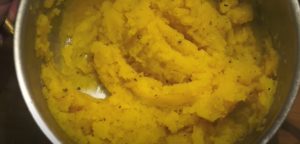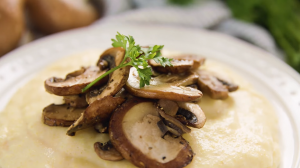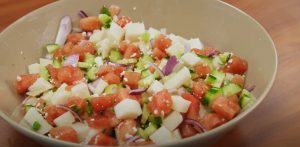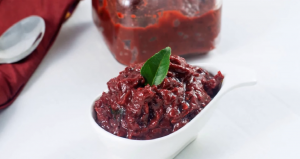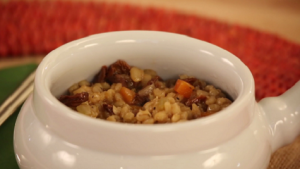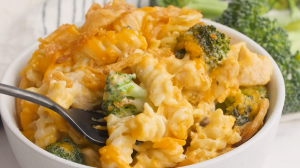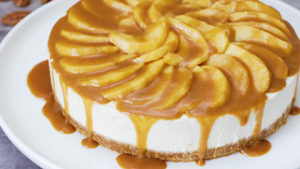These Middle Eastern Pickled Turnips are a staple in many Middle Eastern households. The turnips are brined in vinegar, salt, and a few aromatic spices, resulting in a tangy, crunchy pickled vegetable that's perfect as a condiment or snack.
The key ingredients for this recipe are turnips and beets. While turnips are generally easy to find in most supermarkets, beets are sometimes less commonly available. If you can't find fresh ones, you can use canned beets as an alternative. Be sure to also get high-quality white vinegar and kosher salt, as they greatly influence the flavor of the pickles.
Ingredients for Middle Eastern Pickled Turnips
Turnips: These are the star of the recipe. Turnips have a slightly sweet and peppery flavor that absorbs the pickling brine well.
Beets: These add a sweet earthy flavor and a vibrant red color to the pickles.
Garlic: This adds a subtle hint of pungency, enhancing the overall flavor of the pickles.
White vinegar: It's the main pickling agent that gives the turnips their tangy flavor.
Kosher salt: This helps in the pickling process, and it also seasons the turnips.
Bay leaves: These lend a subtle herbal flavor to the pickles.
One reader, Gianna Allison says:





This Middle Eastern pickled turnips recipe is a game-changer! The tangy and crunchy turnips are a perfect addition to any meal. The flavors are so vibrant and the recipe is easy to follow. I love how it adds a burst of color and flavor to my dishes. Highly recommended!
Key Techniques for Perfect Pickled Turnips
How to prepare the pickling liquid: Dissolve the kosher salt in water with bay leaves, then let it cool before adding the vinegar.
How to prepare the turnips and beets: Peel and slice the turnips and beet into the desired shape for pickling.
How to store the pickled turnips: Place the pickled turnips in a tightly sealed container and refrigerate for at least 5 days before serving.
How To Make Middle Eastern Pickled Turnips
A Middle East staple, pickled turnips are an incredible side to dishes like hummus, flatbread, falafels, and shawarmas. Leaving you craving for more!
Serves:
Ingredients
- 3cupswater
- ⅓cupkosher salt
- 2bay leaves
- 1cupwhite vinegar
- 2½lbsturnips,peeled and cut into ½-inch thick batons
- 1smallbeet,cut into ½-inch thick batons
- 2clovesgarlic,roughly chopped
Instructions
-
In a medium-sized pot, add the water, Kosher salt, and bay leaves.
-
Heat on medium heat, stirring for about 3 to 5 minutes until salt is completely dissolved.
-
Let cool completely then add the vinegar.
-
In a large container with a tight fitting lid, add your turnips and beets.
-
Add the garlic. This can be a very rough chop since it is only for seasoning.
-
Pour the liquid into the container. Let sit for 5 days.
-
Best served refrigerated.
Recipe Notes
The pickles are usually good for about a month.
Nutrition
- Calories: 24.97kcal
- Fat: 0.09g
- Saturated Fat: 0.01g
- Monounsaturated Fat: 0.01g
- Polyunsaturated Fat: 0.04g
- Carbohydrates: 5.11g
- Fiber: 1.41g
- Sugar: 2.96g
- Protein: 0.73g
- Sodium: 312.73mg
- Calcium: 25.57mg
- Potassium: 150.11mg
- Iron: 0.29mg
- Vitamin A: 0.31µg
- Vitamin C: 15.22mg
Pro Tip for Achieving the Perfect Texture
To ensure your pickled turnips have a vibrant pink color, choose a beet that is deep red. The beet not only adds a sweet, earthy flavor but also gives the turnips their signature pink hue. The longer the turnips sit in the pickling liquid, the deeper their color will become. So, if you prefer a more intense color and flavor, you can let them sit for more than 5 days. Just remember to keep them refrigerated to maintain their freshness.
Time-Saving Tips for Making Middle Eastern Pickled Turnips
Prepare the ingredients: Gather and prepare all the ingredients and equipment before starting the pickling process to streamline the cooking process.
Use a mandoline: Slice the turnips and beets using a mandoline to ensure uniform thickness, saving time and ensuring even pickling.
Label and date: Label the pickling container with the date of preparation to keep track of the pickling progress and ensure timely consumption.
Check for readiness: Periodically check the pickled turnips for readiness to ensure they are pickled to your desired taste and texture.
Storage organization: Organize your pickled turnips in a well-labeled and dated manner in the refrigerator for easy access and tracking.
Substitute Ingredients For Middle Eastern Pickled Turnips Recipe
water - Substitute with vegetable broth: Vegetable broth can add a rich and savory flavor to the pickling liquid, enhancing the overall taste of the pickled turnips.
kosher salt - Substitute with sea salt: Sea salt can provide a similar level of salinity and can dissolve easily in the pickling liquid.
bay leaves - Substitute with dried oregano: Dried oregano can impart a slightly different herbal note to the pickling liquid, adding a unique flavor profile to the turnips.
white vinegar - Substitute with apple cider vinegar: Apple cider vinegar can offer a slightly milder and fruitier acidity, complementing the turnips and beet in the pickling process.
turnips - Substitute with radishes: Radishes can be a suitable substitute, offering a similar crunchy texture and ability to absorb the pickling flavors.
beet - Substitute with red cabbage: Red cabbage can provide a vibrant color and a slightly sweet and earthy flavor, similar to beets, to the pickled turnips.
garlic - Substitute with shallots: Shallots can add a mild onion flavor to the pickling liquid, complementing the turnips and enhancing the overall taste.
Creative Ways to Serve Pickled Turnips
Elevate the turnip slices: Arrange the pickled turnip slices in a circular pattern on the plate, slightly overlapping each other to create a visually appealing presentation.
Garnish with microgreens: Sprinkle a handful of delicate microgreens over the pickled turnips to add a pop of color and a fresh, herbaceous flavor.
Drizzle with olive oil: Finish the dish with a light drizzle of high-quality olive oil to enhance the flavors and add a glossy sheen to the pickled turnips.
Serve on a rustic wooden platter: Present the pickled turnips on a beautifully crafted wooden platter to create a warm and inviting visual appeal that complements the earthy flavors of the dish.
Accompany with artisanal bread: Serve the pickled turnips alongside freshly baked artisanal bread to provide a delightful textural contrast and an additional element of flavor to the dish.
Use a minimalist approach: Embrace simplicity by allowing the vibrant colors and textures of the pickled turnips to take center stage, creating an elegant and refined presentation.
Incorporate edible flowers: Introduce a touch of elegance by delicately placing edible flowers, such as nasturtiums or pansies, around the pickled turnips for a visually stunning and sophisticated presentation.
Essential Equipment for Making Middle Eastern Pickled Turnips
- Cutting board: Used for chopping and preparing ingredients.
- Chef's knife: Essential for cutting and slicing various ingredients with precision.
- Large container with lid: Used for pickling the turnips and beets.
- Medium-sized pot: Used for heating the pickling liquid.
- Mixing spoon: Used for stirring the pickling liquid and ensuring all ingredients are well combined.
- Measuring cups and spoons: Essential for accurately measuring the ingredients.
- Vegetable peeler: Used for peeling the turnips and beet.
- Garlic press: For crushing the garlic cloves to release their flavor into the pickling liquid.
Storing and Freezing Middle Eastern Pickled Turnips
Here are the storing and freezing guidelines for Middle Eastern pickled turnips:
- Store the pickled turnips in an airtight container or jar with a tight-fitting lid in the refrigerator for up to 1 month. The cool temperature will help preserve their crunch and flavor.
- For longer storage, you can freeze the pickled turnips for up to 6 months. To do this:
- Remove the turnips from the pickling liquid and pat them dry with a paper towel.
- Place the turnips in a single layer on a baking sheet lined with parchment paper and freeze until solid, about 2-3 hours.
- Transfer the frozen turnips to a freezer-safe container or resealable plastic bag, removing as much air as possible before sealing.
- Label the container with the date and contents.
- To thaw the frozen pickled turnips, transfer them to the refrigerator and let them defrost overnight. They may lose some of their crunch after freezing and thawing, but the flavor will still be delicious.
- If you have leftover pickling liquid, you can store it in a separate airtight container in the refrigerator for up to 1 month. Use it to pickle more vegetables or as a flavorful addition to salad dressings or marinades.
Fascinating Facts About Middle Eastern Pickled Turnips
Pickled turnips are a popular Middle Eastern condiment, often served alongside falafel or shawarma. They are known for their vibrant pink color, which comes from the addition of beets to the pickling liquid. This colorful addition not only enhances the visual appeal but also adds a subtle sweetness to the tangy turnips. The pickling process not only preserves the turnips but also infuses them with a unique flavor profile, making them a versatile and delicious addition to many dishes.
Is Making Pickled Turnips at Home Cost-Effective?
This Middle Eastern pickled turnips recipe is highly cost-effective for a household. Turnips and beets are affordable, and the minimal use of ingredients keeps the cost low. The pickling liquid mainly consists of water, salt, and vinegar, which are pantry staples. The recipe yields a large batch, providing plenty of pickled turnips for multiple servings. The approximate cost for a household of 4 people is around $5-$7, making it an economical choice. Overall Verdict: 9/10
Are Middle Eastern Pickled Turnips Healthy?
This pickled turnip recipe can be considered relatively healthy due to its low-calorie content and the use of natural ingredients. The main components, turnips and beets, are nutrient-dense vegetables that provide essential vitamins, minerals, and fiber. The pickling process also helps preserve these nutrients while adding a tangy flavor to the dish.
However, there are a few aspects of the recipe that could be improved to make it even healthier:
- The salt content is quite high, which may be a concern for individuals with high blood pressure or those watching their sodium intake. Reducing the amount of salt used in the brine could make the recipe more heart-healthy.
- While white vinegar is a common choice for pickling, using apple cider vinegar instead could provide additional health benefits due to its antioxidant properties and potential to aid digestion.
To further enhance the nutritional value of this pickled turnip recipe, consider the following suggestions:
- Add more vegetables to the mix, such as carrots, bell peppers, or cauliflower, to increase the variety of vitamins and minerals in the dish.
- Include additional herbs and spices like mustard seeds, peppercorns, or dill, which can provide extra flavor and potential health benefits without increasing the calorie count.
- Experiment with using a sugar substitute or reducing the amount of sugar used in the brine to lower the overall sugar content of the recipe.
Editor's Opinion on This Pickled Turnip Recipe
This Middle Eastern pickled turnips recipe is a delightful blend of flavors and textures. The combination of turnips, beets, and garlic, pickled in a brine of water, salt, bay leaves, and vinegar, creates a tangy and vibrant dish. The simplicity of the ingredients allows the natural flavors to shine through, while the pickling process infuses them with a delightful zing. The result is a versatile condiment that adds a pop of color and flavor to any dish. Enjoy these pickled turnips as a side, in sandwiches, or as a topping for salads. Refrigerate for the best flavor and crunch.
Enhance Your Middle Eastern Pickled Turnips Recipe with These Unique Side Dishes:
Similar Recipes to Try If You Love Pickled Turnips
Ideal Main Courses and Desserts to Pair With Middle Eastern Pickled Turnips
Why trust this Middle Eastern Pickled Turnips Recipe:
This recipe for pickled turnips is a classic Middle Eastern favorite, passed down through generations. The combination of vinegar and kosher salt creates the perfect brine for preserving the turnips' crisp texture and unique flavor. The addition of bay leaves and garlic infuses the turnips with aromatic and savory notes. The use of beets not only adds a beautiful pink hue but also enhances the overall flavor profile. Trust in the traditional methods and ingredients used in this recipe to bring an authentic taste of the Middle East to your table.
Was this page helpful?
Have your own special recipe to share? Submit Your Recipe Today!




